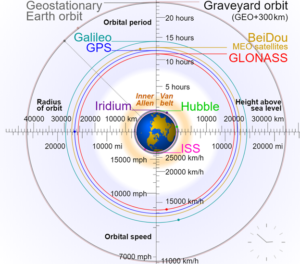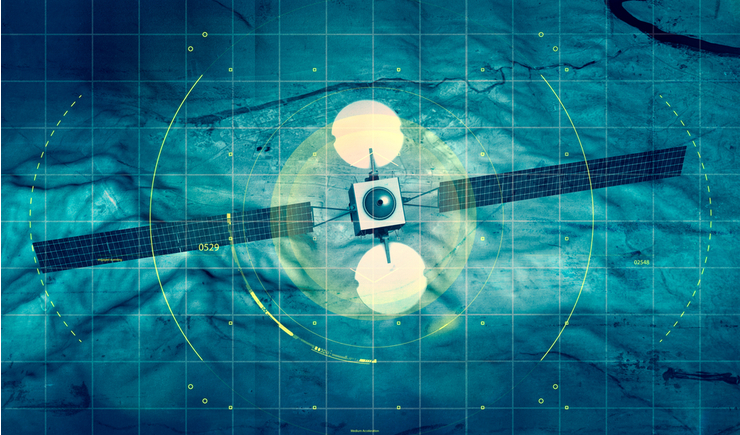On January 22nd, a Chinese Satellite named SJ-21 went missing from its previous orbital path. An immediate proximity search turned up nothing, so a broader search was conducted. SJ-21 was found, but it was surprisingly out of place, and moving towards a decommissioned Compass G2 satellite. Once it intercepted the G2 satellite, the SJ-21 grabbed it, and threw it into a higher orbital path known as “the graveyard orbit.”

Orbit size comparison of GPS, GLONASS, Galileo, BeiDou-2, and Iridium constellations, the International Space Station, the Hubble Space Telescope, and geostationary orbit (and its graveyard orbit), with the Van Allen radiation belts and the Earth to scale.
Recently, China has been launching satellites classified as On-Orbit Servicing, Assembly, & Manufacturing (OSAM) satellites. These devices are cable of getting close to and interacting with other satellites. Both Russia and China have raised concerns by launching these types of satellites because of their potential for military use as anti-satellite weapons. Fears heightened in February of 2020 after Russia maneuvered two of its satellites to stalk one owned by the U.S. government. The U.S. is now also concerned over China’s recent rapid developments in space. Brett Tingley from The Drive reports (abridged):
A Chinese satellite was observed grabbing another satellite and pulling it out of its normal geosynchronous orbit and into a “super-graveyard drift orbit.” The maneuver raises questions about the potential applications of these types of satellites designed to maneuver close to other satellites for inspection or manipulation and adds to growing concerns about China’s space program overall.
On January 22, China’s Shijian-21 satellite, or SJ-21, disappeared from its regular position in orbit during daylight hours when observations were difficult to make with optical telescopes. SJ-21 was then observed executing a “large maneuver” to bring it closely alongside another satellite, a dead BeiDou Navigation System satellite. SJ-21 then pulled the dead satellite out of its normal geosynchronous orbit and placed it a few hundred miles away in what is known as a graveyard orbit. These distant orbits are designated for defunct satellites at the end of their lives and are intended to reduce the risk of collision with operational assets. […]
VIDEO: ExoAnalytic Solutions tracking of Chinese satellite SJ-21. This video shows our global telescope network tracking and maintaining custody of SJ-21 as it performs rendezvous and proximity operations with COMPASS G2 (BEIDOU G2). SJ-21 performs a large maneuver docked with COMPASS G2 and releases it in a different orbit a few days later.Still, if SJ-21 can grab a dead satellite and move it out of orbit, there is likely little stopping it from doing the same thing to an operational one the American military depends upon. It’s important to note that the United States is also exploring on-orbit servicing capabilities that will likely prompt similar concerns from America’s competitors. Northrop Grumman is developing a satellite featuring a DARPA-made robotic arm for a planned launch in 2024 that is capable of “detailed inspections, relocations of client vehicles or simple repairs such as releasing a solar array that is stuck or an antenna that doesn’t deploy properly.”
China and Russia are not alone in developing new weapon technologies for space. The U.S. has what’s known as the Mission Robotic Vehicle (MRV) in the works, built by Space Logistics LLC, a wholly owned subsidiary of Northrop Grumman. The device will feature a robotics suite developed by DARPA and the Naval Research Laboratory. It will include a robotic arm with 21 cameras and will use LIDAR (light detection and ranging) to calculate distances. The first launch of the technology is planned for 2023. Read more from DARPA:
DARPA funds the U.S. Naval Research Laboratory (NRL) to integrate the flight robotic payload elements, including the robotic manipulator arms, a variety of interchangeable tools, cameras and sensors, and the software and avionics to operate the payload elements
Eyeing a launch in 2023, DARPA’s Robotic Servicing of Geosynchronous Satellites (RSGS) program will focus the remainder of this year on completing the elements of the robotic payload. The objective of RSGS is to create an operational dexterous robotic capability to repair satellites in geosynchronous Earth orbit (GEO), extending satellite life spans, enhancing resilience, and improving reliability for the current U.S. space infrastructure.
Earlier this year, DARPA partnered with Space Logistics LLC, a wholly owned subsidiary of Northrop Grumman, to provide the spacecraft bus, launch, and operations of the integrated spacecraft. DARPA will provide the payload that flies on the bus, including the robotic arms, through an agreement with the U.S. Naval Research Laboratory (NRL).
Testing the MRV’s Flight Robotic Arm System #1 “Gauntlet” Comprehensive Trajectory
In 2021, NRL will integrate the robotic arms onto the payload structure, and then is expected to begin environmental tests by the end of same year. After launch in 2023, it will take approximately nine months to reach GEO, and the program anticipates servicing satellites in mid-2024.
The Future of Satellite Servicing in Space
Steve Schneider
Latest posts by Steve Schneider (see all)
- New Chinese Electromagnetic Surveillance Leaves “Nowhere to Hide” on Battlefield - March 15, 2024
- Amazon’s Nuclear Powered Data Center - March 7, 2024
- Skunk Works Rolls Out An Engineering Marvel - March 6, 2024
- Future of Airpower Takes First Flight - March 4, 2024
- A War Beneath the Waves – Trillions of Dollars at Stake - February 9, 2024

















